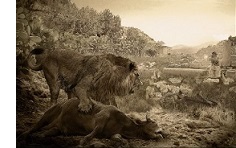There are very few taxidermy specimens of Barbary Lions. Over the past 15 years my colleague, Dr Nobuyuki Yamaguchi has spent months attempting to locate these treasures, following the footsteps of Vratislav Mazak, the famous biologist who had previously tracked down many specimens in the 1960s. Sadly some of these items have gone missing over the past 40 years.

“The thief of Beja” by V. Simeonovski (click image to see full size version)
Only one specimen, in Leiden’s Naturalis Museum in the Netherlands, includes clear information on its provenance. Leading widlife artist Velizar Simeonovski has recreated the scene, showing the male lion being shot at close range (thumbnail link, right) by a local Tunisian defending his livestock. Velizar also offers an interesting commentary on the story.
Th male lion at Beja was shot in 1823, over a hundred years before the last lions dissappeared from the region. Whilst many of the subsequent encounters between people and lions in North Africa include livestock predation by lions it is also true that lions became more adept at withdrawing into remote areas away from human contact. In the 20th century only one third of the 30 encounters with lions resulted in the animal being shot and only two incidents involved livestock attacks.
Reading:
Black SA, Fellous A, Yamaguchi N, Roberts DL (2013) Examining the Extinction of the Barbary Lion and Its Implications for Felid Conservation. PLoS ONE 8(4): e60174. doi:10.1371/journal.pone.0060174
Mazak V (1970) The Barbary lion, Panthera leoleo(Linnaeus, 1758);some systematic notes, and an interim list of the specimens preserved in European museums. Z Saugetierkd 35:34-45
https://archive.org/stream/zeitschriftfrsu351970deut#page/34/mode/1up
Simeonovski, V. (2014) “The thief of Beja” 13 February 1823, the vicinity of Beja , Tunisia. https://www.facebook.com/photo.php?fbid=10200278268637339&set=a.1930331635954.58603.1772149103&type=3&theater
Yamaguchi N, Haddane B. 2002. The North African Barbary lion and the Atlas Lion Project. International Zoo News 49 (321): 465-481.

There is no realy well-establised evidence about Barbary lions being bigger than other lions. Measures of length, height, body mass are difficult to compare without standard field methods. Hunters are also prone to exaggeration! The babrabry lion is usually described as a ‘medium sized lion’. What appears to be unusual is its body size (depth of chest) relative to its leg length – you get realtively thick-set animals. Of course in males there is also the shaggy mane which amplifies the size of the animal. Have a look at the blog “Big shaggy beast & other myths”. The biggest animal in captivity that I have seen was a male at Port Lympne which weighed 250kgs in the 1980s, which is truly huge (siberian tiger size), although I do not know what condition the animal was in, although I discussed this with his keeper and it appears the animal was in its prime. I personally have seen a captive late-adolescent/young adult male weighed in at 185kgs during a transfer – large compared to average sub-saharan or Indian animals in the wild.
Barbary lions are the largest subspecies? What is the size of them in captivity?